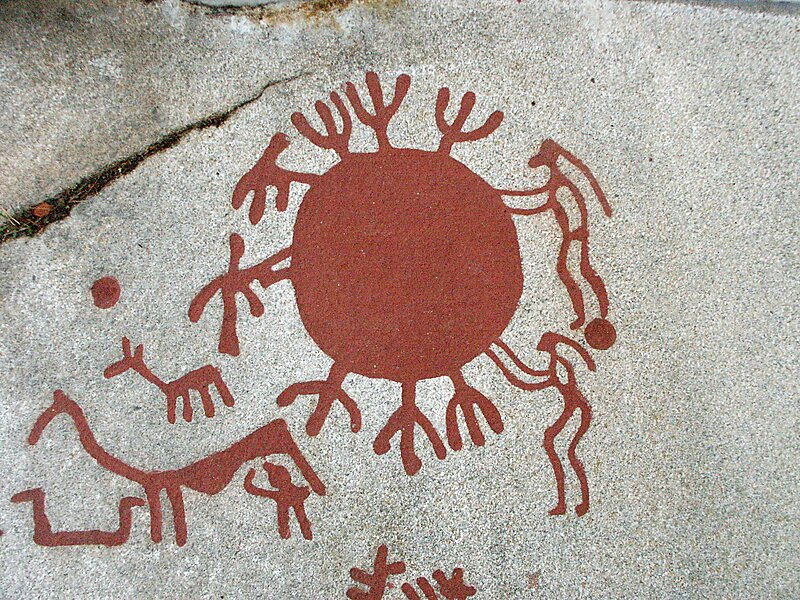Sweden South & West Aug 31-Sept 4 2018
SKÁNE (Scania)
The most continental part of Sweden is connected to Denmark by bridge from Malmo. Flat, it has fields (it is Sweden’s larder), sandy coastlines and castles.
ØRESUND or ÖRESUNG BRIDGE
This combined railway and motorway bridge across the Øresund strait between Sweden and Denmark is nearly 8 kilometres from the Swedish coast to the artificial island Peberholm in the middle of the strait. The crossing is completed by the 4-kilometre Drogden Tunnel from Peberholm to the Danish island of Amager.
The Øresund Bridge is the longest combined road and rail bridge in Europe and connects two major metropolitan areas: Copenhagen and Sweden’s Malmö. It connects the road and rail networks of the Scandinavian Peninsula with those of Central and Western Europe. A data cable also makes the bridge the backbone of internet data transmission between central Europe and Sweden.
The international European route E20 crosses via road, the Oresund Line via railway. The construction of the Great Belt Fixed Link (1988-1998), connecting Zealand to Funen and thence to the Jutland Peninsula, and the Øresund Bridge have connected Central and Western Europe to Scandinavia by road and rail.
The justification for the additional expenditure and complexity related to digging a tunnel for part of the way, rather than raising that section of the bridge, was to avoid interfering with air traffic from the nearby Copenhagen Airport, to provide a clear channel for ships in good weather or bad, and to prevent ice floes from blocking the strait.
In accordance with the Schengen Agreement and the Nordic Passport Union, there are usually no passport inspections. There are a few random customs checks at the entrance toll booths entering Sweden, but not when entering Denmark. Since January 2016, checks have become significantly more stringent due to the European migrant crisis.
History. Construction began in 1995, with the bridge opening to traffic on 1 July 2000.
The concept of a bridge over the Øresund was motivated to improve transport links in northern Europe, from Hamburg to Oslo, regional development around the Øresund, to connect the two largest cities of the region and improve connections to Kastrup airport, the main flight transportation hub in the region.
Although traffic between Denmark and Sweden increased by 61 percent in the first year after the bridge opened, traffic levels were not as high as expected, perhaps due to high tolls. However, since 2005, traffic levels have increased rapidly. This may be due to Danes buying homes in Sweden to take advantage of lower housing prices in Malmö and commuting to work in Denmark. To cross by car cost DKK 310, SEK 375 or €43, with discounts of up to 75% available to regular users. In 2007, almost 25 million people travelled over the Øresund Bridge: 15.2 million by car and bus and 9.6 million by train. By 2009, the figure had risen to 35.6 million by car, coach or train.
In January 2016, amidst the European migrant crisis, Sweden was granted a temporary exemption from the Schengen Agreement in order to mandate that all travellers across the bridge had photographic proof of identity. The move marked a break with 60 years of passport-free travel between the Nordic countries.
Bridge. At 7,845 m (25,738 ft), the bridge covers half the distance between Sweden and the Danish island of Amager, the border between the two countries being 5.3 km (3.3 mi) from the Swedish end. The structure supports two railway tracks beneath four road lanes in a horizontal girder extending along the entire length of the bridge. On both approaches to the three cable-stayed bridge sections, the girder is supported every 140 m (459 ft) by concrete piers. The two pairs of free-standing cable-supporting towers are 204 m (669 ft) high allowing shipping 57 m of head room under the main span, but most ships’ captains prefer to pass through the unobstructed Drogden Strait above the Drogden Tunnel. The cable-stayed main span is 491 m (1,611 ft) long.
The bridge experiences occasional brief closures during very severe weather, such as the St. Jude storm of October 2013.
Due to high longitudinal and transverse loads acting over the bridge and to accommodate movements between the superstructure and substructure, it has bearings weighing up to 20 t each. Vibration issues, caused by several cables in the bridge moving under certain wind and temperature conditions, were combatted with compression spring dampers installed in pairs at the centre of the cables.
Peberholm. The bridge joins Drogden tunnel on the artificial island of Peberholm (Pepper Islet). Peberholm is a designated nature reserve built from Swedish rock and the soil dredged up during the bridge and tunnel construction, approximately 4 km (2.5 mi) long with an average width of 500 m (1,640 ft). It is 20 m (66 ft) high.
Drogden Tunnel. The connection between Peberholm and the artificial peninsula at Kastrup on Amager island, the nearest populated part of Denmark, is through the 4,050-metre long Drogden Tunnel. It comprises a 3,510-metre immersed tube plus 270-metre entry tunnels at each end. The tube tunnel is made from 20 prefabricated reinforced concrete segments – the largest in the world at 55,000 tons each – interconnected in a trench dug in the seabed. Two tubes in the tunnel carry railway tracks, two carry roads and a small fifth tube is provided for emergencies. The tubes are arranged side–by–side.



Cost. The cost for the Øresund Connection, including motorway and railway connections on land, was DKK 30.1 billion (~€4.0 bn) according to the 2000 year price index, with the cost of the bridge expected in 2003 to be recouped by 2037. The connection will be entirely user-financed. The owner company is owned half by the Danish state and half by the Swedish state. Tax money has been used for the land connections. According to The Öresund Committee, the bridge has made a national economic gain of DKK 57 billion, or SEK 78 billion. The underwater parts of the bridge have become covered in marine organisms and act as an artificial reef.
Cost of one car: SEK460, €43.
MALMÖ (pop 229,000)
Sweden’s third largest city has an old town and Vastra Hammen with much new vibrant architecture. The bridge connects to Copenhagen and its busy international airport making an urban conglomeration. Germany is a short hop across the Baltic and more than 150 nationalities call Malmö home.
Malmöhus Slott. Erik of Pomerania built the first fortress here in 1436 but it was destroyed in a popular uprising between 1534-36. All that remains is the part with the decorative white bands. It was rebuilt but devastated by fire in 1870 and this functional, factory-like building was added in the 1930s to what remained of the old building and intact gun towers. Today it holds the Malmö Museum with three museums: Malmo Konstmuseum (art), Stadsmuseum (city museum – Malmö from the 1850s to today) and an Aquarium with a nocturnal hall, reptiles, spiders and other cold-blooded animals including dinosaurs. SEK40


Moderna Museum. In a 1901 power-generating turbine hall with a contemporary annex, this has rotating exhibits. I enjoyed both: the ground floor had the Russian/Polish couple, Wladyslaw Strzeminski (geometric abstracts) and Katarzyna Kobro (geometric sculpture) and the upstairs was a collection of very old photography from the 1800s and early 20th century: Carlton Watkins (1829-1916; USA, many photos of Yosemite NP in California), Julia Cameron (Edinburgh, intimate portraits of her family), Carl Malmberg (Finland) and Nils Trindberg (Sweden, documented the Andrée’s Arctic Balloon exhibition in 1897). Free
Stadsbibliotek. The Malmö city library is housed in an older brick building with a huge new annex highlighted by a 4-story open atrium surrounded by glass. Like many public libraries, there are reading rooms with many daily newspapers, magazines, computer labs and work spaces. Free
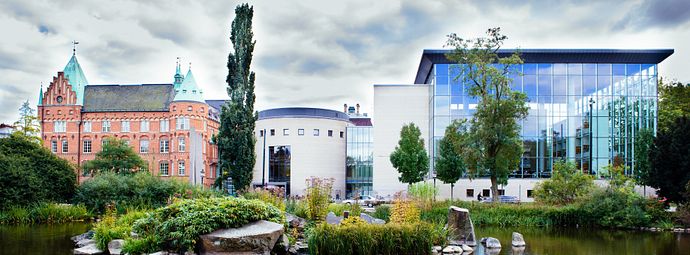

Vastra Hammen. 2.5kms north of old town, this is the modern face of Malmö and a good place to see the Oresund bridge.
Turning Torso is a neo-futurist residential skyscraper in Malmö and the tallest building in Scandinavia. It opened in 2005 and is regarded as the first twisted skyscraper in the world. The project was designed by Spanish architect, structural engineer, sculptor and painter Santiago Calatrava, is 190 metres (623 ft) high with 54 storeys. In 2015, it won the 10 Year Award from the Council on Tall Buildings and Urban Habitat and in 2005 Gold Emporis Skyscraper Award.
It is a solid immobile building constructed in 9 segments of 5-story pentagons that twist relative to each other and the topmost segment is 90 degrees clockwise with respect to the ground floor. Each floor is an irregular pentagon rotating around the vertical core supported by an exterior steel framework. The two bottom floors are offices and segments 3-9 have 147 apartments. The apartments were initially supposed to be sold but insufficient interest resulted in them being rented. Floor 49 is home to the public observation deck (since 2009, the public can visit these floors but only on special scheduled days, and pre-booking is required), while floors 50–52 contain a private club, meeting events, the reception, and the venue restaurant.
The owners have several times unsuccessfully tried to sell the building as the construction costs were almost double the estimate.
On 18 August 2006, Austrian skydiver Felix Baumgartner parachuted onto the Turning Torso, and then jumped off it.

Inkonst. This underground performance venue has 3 stages (the Black Box, the Club and a third small stage) presenting performing arts, mostly electronic music, culminating in the Intonal Festival in April. A show on Retro-Games was being set up when I was there. The director of the centre kindly gave me a small tour. Like many museums and theatres in Sweden, they are supported by government grants. Free
Emporia Mall. In the Nomad Mania “modern architecture” series, this shopping mall is all coloured plexiglass: a blue/yellow parking garage, yellow façade on one side and inside different escalators and balconies are various colours.
It opened in 2012, has approximately 200 shops over 93,000 m² and three stories topped with a roof terrace measuring 27,000 m², equivalent to approximately four soccer fields. In total, the mall employs around 3,000 people. According to Emporia, they have around 25,000 visitors per day.


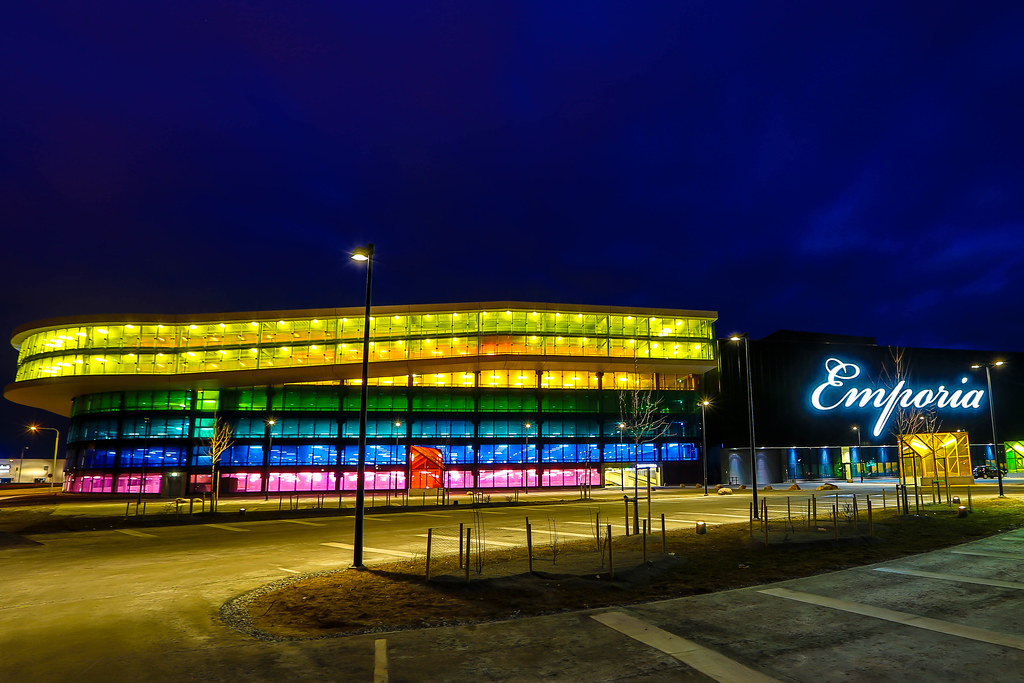
Parking Garage
Alnarp Manor. Just north of Malmö, this 3-story brick manor house is surrounded by a lovely park with mature trees. There are no signs on the building but I was told that it is a college about landscape architecture.
Varnhem Abbey. The only Varnhem on Google Maps was a suburb of Malmö but an abbey was not discoverable and the several long-term residents I asked directions from had never heard of Varnhem Abbey. So I went to the Varnhem suburb of Malmö and looked around. I found St Pauli’s Church, a grand hexagonal building built in 1882 with silver metal steeples – 12 small ones for the apostles and a large central tower for Christ. Four sides at ground level have stained glass added in the 1950s and the two upper levels each have big clear windows giving it a bright inside.
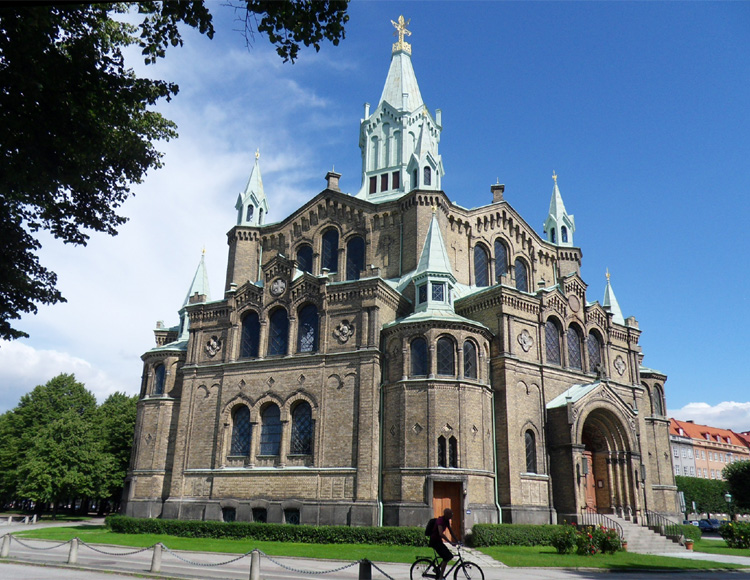

There are three large cemeteries that extend for several city blocks south of the Church called St Pauli’s Cemetery.
Of significance, this church is on the Swedish Compostela de Santiago route. Called Skane Bleking, it connects Trelleborg on the south tip of Sweden with Vadstena in Sweden and Nedaros in Norway. The cathedral at Lund serves as the hub of the two camino routes.
The real Varnhem Abbey is located NE of Göteberg very near the town of Skövde.
Marsvinsholm Slott. About 12kms west of Ystad, this fine moated castle with two towers is a private residence. Their main season is from June to mid-August when the sculpture park has exhibits that change yearly and the an Open Air Theatre operates.
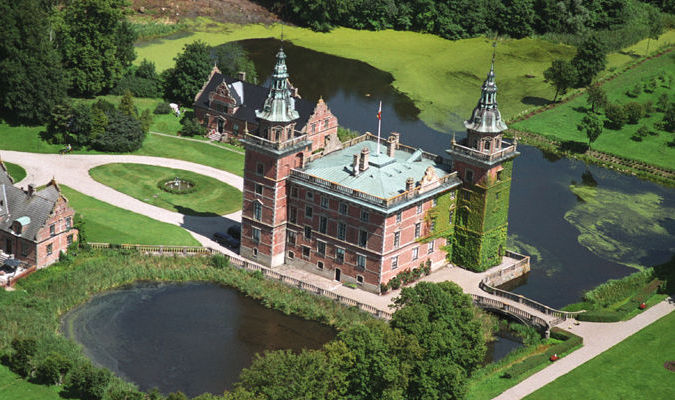
YSTAD (pop 30,000)
About 55kms east of Malmö on the south coast, Ystad was a medieval market town – Sweden’s window to Europe from the 17th to the mid 19th centuries with new ideas and inventions – cars, banks and hotels arrived here first. Now it is a popular tourist destination with its half-timbered houses, cobbled streets and the setting of the best-selling Inspector Wallander crime thrillers. Pilgrändshuset is Scandinavia’s oldest half-timbered house dating from 1480. A nightwatchman sounds his horn from the Sankta Maria Church clock tower, a tradition dating from 1250.
It is also the terminal for ferries to Poland and the Danish island of Bornholm.
Sankta Maria Kyrka. Highlights are the ornate 17th century pulpit, pipe organ, chandeliers and acoustics.
Klostret i Ystad. This Franciscan abbey/monastery dates from 1267. Know for their piety, the 15-20 friars prayed every 3 hours, worked around the town, fished and had a garden. After the 1532 Reformation, the church was a hospital and then became a Lutheran church. But Sankta Maria was the main church and the monastery went into a long decline functioning as a distillery to 1787, a granary for wheat until 1871 and then empty. Demolishing seemed to be the best option but the town took it over, renovated it in the 1950s and it is now used for exhibitions and concerts with the dormitories a museum.
The whitewashed interior of the church has some very faded frescoes, but it otherwise plain inside. SEK50

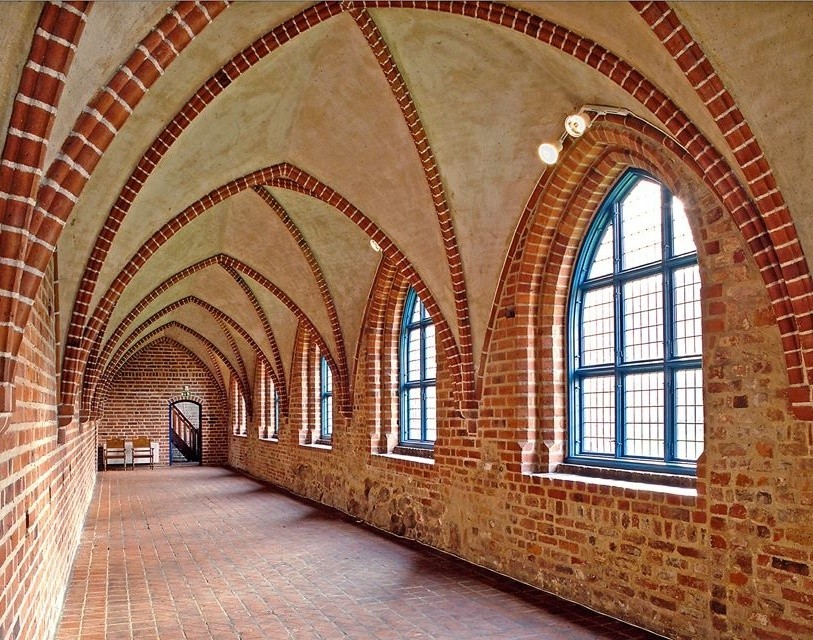
Konstmuseum Ystad. In the same building as the tourist centre across from the train station, this art museum has a permanent exhibition of Danish and Swedish paintings.
Artists often share space with writers and poets in approximately 8 temporary exhibits yearly. The one being set up when I was there were two musicians with a show entitled Beirut, Beyrut, Bayrut, Beyrouth, Beyrout. SEK50
Charlotte Berlins Museum. Behind the above museum is this small yellow house. Charlotte Josephina Euphrosyne Aurora Constantia Berlin
(1841-1916) was a piano teacher and good at investing money in shares, which led her fortune to grow. She bought the house at Dammgatan in 1881, where the museum is today and moved in with her girlfriend Ingrid Tullberg. Charlotte Berlin was interested in furnishings and acquired modernities like phone and linoleum mats and collected bells. She wanted a museum to be created with her collections. After her death, her wishes were met and the museum opened in 1918. The book The most original Miss Charlotte Berlin, 2016 has been published about her life.
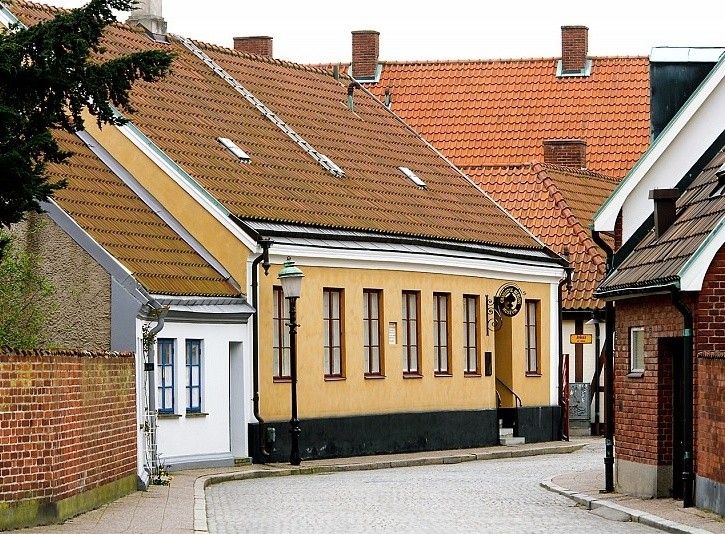
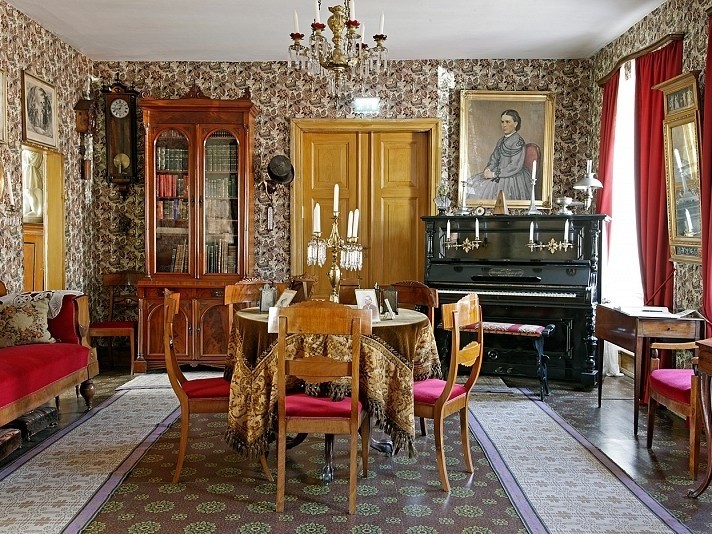
BORNHOLM
This Danish Island is most easily reached from Ystad, an 80-minute ferry ride. On the island are several NM ticks (an area, an island, 3 museums, a fort ruins, 2 lighthouses and 5 (boring) windmills. Otherwise there was not of much interest for me. There are 4 ferries per day (departure 08:30, 12:30, 16:30, 20:30, return 2 hours earlier than those times). Ferries also go from Køge in Denmark.
Buy your tickets online!! To buy them in the terminal involved a DK100 booking fee and the online prices are less. Cost DK149 each way in the terminal. And I would have had to book my return time to avoid another DK100 booking fee! Then there was the bus to get around the island to see all of the above and museum costs. So it would have been a relatively expensive day to see things I have little interest in. I decided not to go.
Besides I am running short of time if I want to see 6 more countries before the end of September when my Schengen visa runs out.
Day 2. I returned to pass Malmö to the east to get to Lund.
LUND (pop 119,000)
Founded by the Danes in about 1000AD, it is the second oldest city in Sweden. With its architectural legacy, it may be Sweden’s loveliest city with its medieval old town centered on the cathedral and the oldest, most prestigious university in the country (1666).
In 1103, Lund was made the seat of the archbishop for all of Scandinavia with St Lawrence its patron saint (St Lawrence, originally from Spain, was martyred when he refused to tell the Roman emperor where the town’s treasure was hidden and in 258 was tied to a gridiron and roasted over hot coals). The south of Sweden including Scania remained in Danish hands until 1658 when they became Swedish again. The twin towers date from 1830-80.
Lund Domkyrka. The cathedral is a dirty grey outside and somber gray inside, but has many worthwhile things to see.

The 1123 crypt, the only remnants of the original church, , and several carved stone columns, some with lovely geometrics and two with Finn, the mythological giant who helped construct the cathedral and his wife and baby. A 16th century square well is carved with comical scenes.
Altar. Several remarkable carved grave slabs. Brass from 1290 – 7-candle candelabra with eagles and angels; three columns standing on lions with angels on two and St Lawrence on the third. Gilded 2 X 7 metre retable. 78 choir stalls from 1350 with carvings of dragons, birds, lions, unicorns, green men and Aesop’s Fables. Mosaic on the dome with the Last Judgement by Joakim Skovgaard. Lovely stained glass from 1930.

Astronomical Clock. From 1430, this 8m tall clock was restored in 1837, is still functioning and the highlight to the church. On the very top, two knights cross swords to count the hour. The top half shows times across the heavens with the sun path showing daylight and darkness hours by the seasons, the moon hand rotates through 28 days to show the phases, and the star hand points to the 12 signs of the zodiac over a 24 hour cycle. The face has 24 hours in two 12-hour halves. The bottom half is human time with a 200-year calendar began in 1923. One would have to study all the dials and rings for some time to figure it all out
At 12 noon and 3pm, the clock’s internal organ plays In Dulci Jubilo (a traditional Christmas carol) and the wooden figures whir into action. Two trumpeters raise their instruments and 8 figures march across the front. Amazing!!!! There is always a big crowd to see this performance and I’m glad I waited around to see it.


St Peters Priory. The original monastery was destroyed in 1538 but this serves as the parish church.
Skissernas Museum (Sketch Museum). This art museum tries to show artistic process with a good collection of paintings and sculpture, some of it of huge stature. Formerly a private collection, there are pieces by Joan Miró, Matisse, Raol Dufy, Delaunay and Fernand Léger. The temporary exhibition is The Climate Experiment using art to explore man’s attempt to control weather and climate. Get the guide at the desk for the lovely sculpture park outside. SEK80
I then drove north of Lund paralleling the coast passing a number of large manor houses.
Trollenäs Slot. Another grand, red brick manor house from 1559/1893 with a 5-story tower. Private. Next door is the Nas Gamla Kyrka, a small 12th century church with faded frescoes. There was a wedding occurring when I visited – a choir was singing inside and a band was setting up on the front lawn. It always amazes me the crazy amount of money these couples spend on a fairy tale wedding for a few hours with no better guarantee of success. The average $20-25,000 could be spent in much more productive ways.
Trolleholm Slot. Another big brick manor house with 4 towers, a farm and lovely manicured grounds. Private.
LANDSKRONER. This was one of Sweden’s most important fortified towns founded by King Eric of Pomerania in 1450.
Landskroner Citadell. On the waterfront of Oresund Strait, the original moated, red-brick citadel with round turrets on the corners was built by Denmark’s Christian III in 1559. After Sweden regained this area in 1668, an earthen embankment and another moat were constructed on the outside. Reinforcements were started in 1729 but at such a slow pace they would not have been finished until 2115 and it became a fortified prison until 1919 when it changed to a forced labour camp for women and then a refugee camp.
Golf Museum. At the Landskroner Golf Course is this tiny, quirky golf museum with a rag tag collection of old clubs, golf balls, odd paraphernalia and a small glass case with Henrik Stenson memorabilia – another weird Nomad Mania selection for a museum. Free
HELSINGBORG (pop 107,000)
This is a lovely seaside city with many turreted buildings. Denmark is only 4kms across Oresund Strait and Helsingborg was involved in many battles with Denmark over the centuries until 1710 when the Danish invaders were finally defeated just outside the city.
15 million take the ferry between here and Helsinger, Denmark every year.
Kärnan. This 34m-high, 15m-square tower was the central keep, all that remains of a 1310 medieval castle purposely demolished in 1680 when the fighting stopped. It sits in the middle of a lovely ornamental park just above the church and old town. Climb the stairs in the 1903 octagonal turret to the viewing platform on top. It is only open from 11-3 after August 27th.
Sancta Maria Church (St Mary’s Church). Started in 1350 and not completed until 1450, this dark-red brick church is also is all brick inside. It has a nice painted and gilt bas-relief retable and pulpit and nice stained glass in the altar area.
Dunkers Kultrhus (Dunkers Culture House). Sitting between the yacht harbour and a big square, this lovely white/glass building houses several elements of the city’s art scene: a concert hall and theatre, a culture school in dance, art and theatre for children and a two part museum – a permanent exhibition on the city and an art gallery showing rotating shows. On now was the other half of The Climate Experiment (the original show was in Stockholm and had to be split between here and Lund because of its size) and Miss Lyckat by Samuel West’s Museum of Failure. This novel museum is a collection with no permanent physical space or gallery, but instead produces shows that exhibit all over the world. Basically these are the products and celebrity endorsements of products that went all bad, from Pepsi to Ikea. This exhibit highlights the Swedish plastic bicycle, the Itera. SEK70

I slept on the outside of the marina with several other motor homes. It was lovely and quiet. The lights of Denmark showed up well across Orersund. I was up early for a big drive day. It was a Sunday and I wanted to be in Göteborg in enough time to see most of the museums closed on Mondays.
Day 3
Sofiero Slott. 6kms north of Helsingborg, this palace and gardens are a major tourist sight. They hold a garden festival Aug 24-6. SEK100
Mölle. In the NM “small town” series, this is an attractive village on Oresund with a harbor, marina, 2 sea kayaking shops and many white buildings with black roofs. The 1907 Christmas storm completely destroyed the harbor and many boats. Mölle was known for its cold sea baths with mixed bathing, set up and taken down every year, but after the very cold winter of 1942, were never done anymore.

Kullaberg Nature Reserve. Only 5kms north west of Mölle, this gneiss headland at the tip of a narrow peninsula juts into Oresund and is unusual for flat Sweden as its high point of 187m and 60m cliffs dominate the skyline. The reserve is the most heavily visited reserve in Sweden with ½ million visitors per year. There is a museum, several short walking trails and the termination of the 70km Kullaleden Trail. Just before the point is a lovely looking golf course.
Kullen Lighthouse. The original lighthouse dates to 1561 and a half-scale replica of the tripod with a steel basket burning oak or coal has been rebuilt. All the forest was eventually logged on the peninsula. The present 1900 lighthouse is 78.5m above sea level and the most powerful in Sweden. It was covered in scaffolding.

HALLAND
Mjellby Konstmuseum. Out in the countryside, about 5kms north of Halmstad, , this art museum Hours are short – only 12-5, Monday to Sondag.
Grimeton Radio Station, Varberg. The tours and Museum are all in Danish (although there is an English manual and English tours are given at 3pm). The museum explains the development of radio in its earliest years, in which Grimeton played an important role. It is UNESCO World Heritage listed.
Marconi used radio waves for the first time using previous discoveries – the Hertz transmitter, Branley’s detector, Morse’s telegraph key and the Russian Popoff’s antennae. He transmitted the first wireless from Europe to the USA in 1901 and shared the 1909 Nobel Prize. Radio was initially used at sea and the SOS signal from the Titanic saved 700 lives. At the beginning of WWI, telegraph cables went around the world, but in the early 1920s, transmission without cables took off with Radio Central stationed on Long Island and other stations in New Jersey, Bolinas California, Hawaii, Caernavon Wales and Warsaw Poland. Grimeston in 1924 was Sweden’s contribution. It had short wave in 1938 and today has 20 short wave transmitters. Gradually, FM and TV transmitters were added.
SEK120
GÖTALAND
GÖTEBORG (Gothenborg – pop 680,000)
Sweden’s second city, Göteburg has great museums, two interesting churches, copious architecture, 17th century canals and parks. Unfortunately, a power plant sits in the middle of the waterfront. Old style blue and white trams go almost everywhere. It is a weird city to drive as the driving lanes twist around all the tram lines, but roads have bus lanes, cross walks are speed bumps and a freeway creates difficult exit/entrance issues.
I saw almost everything on the Nomad Mania list but missed the Aeromuseum out at the airport, Liseborg, Alvsberg Fortress and the Volvo Musuem.
Museum of World Culture. This is a lovely museum exploring a wide range of subjects from water, the Anthropocene epoch, democracy, Mecca, Silk Road and music. Free

Konstmuseum. Housed in 6 floors, its permanent collection is separated into European art from 1400-1800, Nordic art 1750-1880, Nordic from the turn of the century, Swedish modernism, Gothenburg Colourists, sculpture by Johan Sergel and a small collection of French impressionists. I enjoyed all the galleries as there was little contemporary art. SEK100
Robsska Museum. Unfortunately it was temporarily closed. Go to www.robsska,se to see their art.
Göteborg Stadmuseum (City Museum). Housed in the old Swedish East India Company building (company was disbanded in 1813), this museum tells the story of Göteborg since its founding in 1621. Göteborg obtained its wealth as a port city that developed industry based on sugar, tobacco, herring and iron. The Vikings are discussed from a Swedish viewpoint Wealth and precious objects can have different meanings for everyone, a subject dealt with well in one exhibit – one of the “objects” was the fascinating Sasters calculating machine. SEK60
Maritiman. This is a collection of 8 large and several smaller boats in the harbor including: 1963 ferry, two mud boats, 1915 lightship, 1931 fireboat, 1875 armoured monitor, 1978 anti-submarine patrol boat, 1938 cargo vessel, 1961 submarine, a huge 1952 destroyer, 3 harbour tugs, 1914 taxi, minelayer, and two lifeboats. SEK140

Sojfarts Museet (Maritime Museum). This has tons of the usual ship models, sailor momentos, immigrant stories and gives a good history of the port and harbor. A temporary exhibit detailed diving fisherwomen on the island of Jeju off the south tip of South Korea. A 1000-year old tradition, most are over 60 and all free dive. SEK100
Masthuggskyrkan. Located on a hill that is one of Gothenbrug’s best viewpoints, it was built in 1914 in a style reminiscent of both the Viking and Medieval periods. Outside the foundation and the south cross are large exposed stone. Inside, the highlight is the log roof using dressed timbers similar to the construction of an inverted log cabin. The triptych and pulpit are lovely painted carved bas-reliefs and it is richly decorated with wood carvings in the beams, railings and pillars. A full-rigged ship, the Java, hangs on the left side. Free

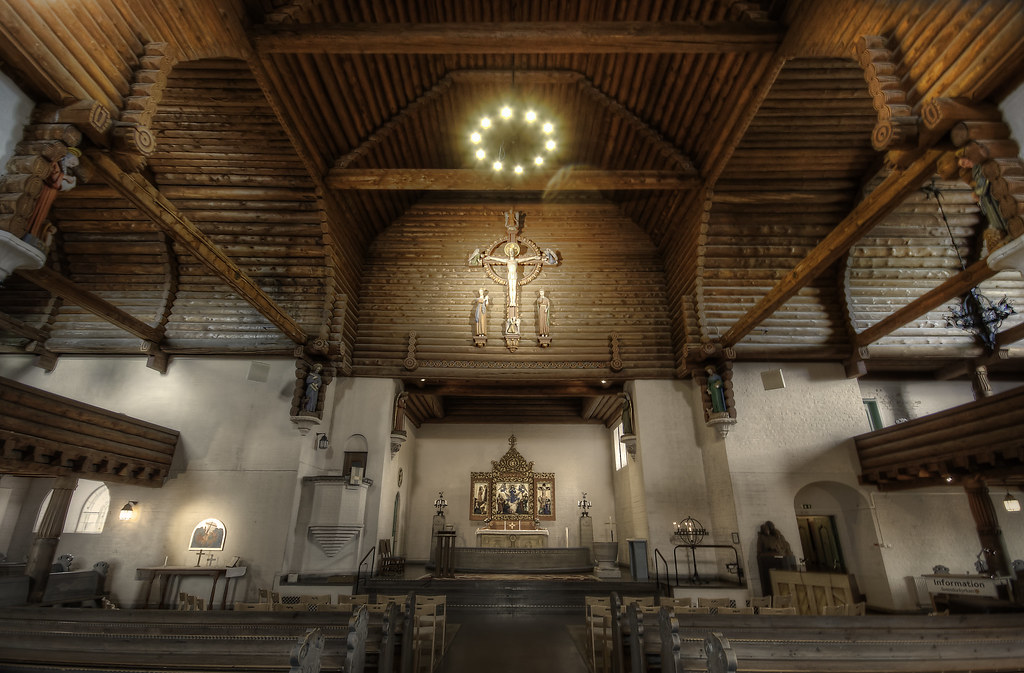


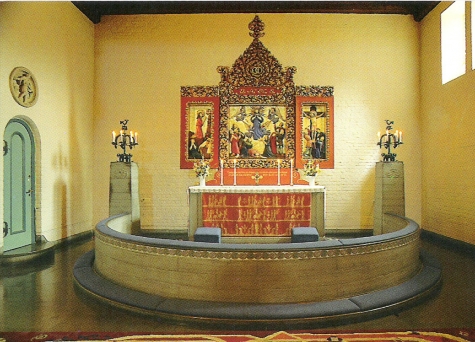
Oscar Fredrik Church. This 1893 church is pretty outside and in. The brown brick exterior has yellow trim and green copper caps and roofs. Inside, the arches are the same height as the aisles and light streams in through the pale pastel windows and two large rose windows. Free
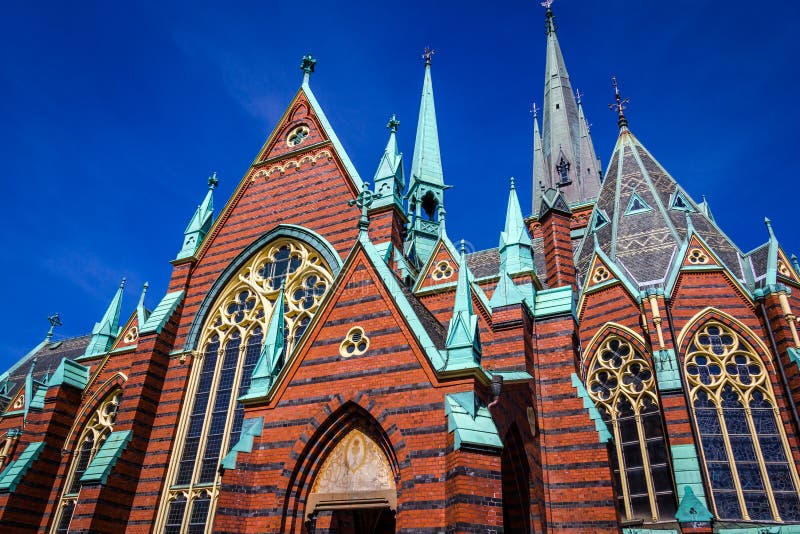
Skansen Kronar (Crown Redoubt). On top of Skansbeiget Hill, this 1687 four-story tower with a crown of gilded wood used to have a fortress with ramparts surrounding it. It never fired a shot. The fortification was demolished in 1807 and the tower has been used as a prison, emergency housing and a museum. As the city slowly surrounded it, the locals built a park. It is a lovely and busy viewpoint. It can’t be entered. Free

Röda Sten Konsthall. In a 1940 former electrical generation plant near the water, this contemporary art museum has 4 floors of exhibits that change 4-6 times per year. Most of the pieces are large installation art. The name Röda Sten comes from a mythical red stone on the shore west of the building. As with most contemporary art, I don’t appreciate this stuff. I laugh at the philosophical write-ups as “experts” attempt to explain this “crap”. Entrance by donation SEK40 suggested.
Pustervik. This performance venue attracts local and international acts with an on-site café/bar and restaurant. It is usually packed and tickets need to purchased early.
Nya Ullevi. Usually just called Ullevi, this large, futuristic stadium with a swooping roofline is multipurpose. The stadium is one of the biggest in the Nordic countries, with a seating capacity of 43,000 and a total capacity of 75,000 for concerts.
It was built for the 1958 FIFA World Cup, but since then has also hosted the World Allround Speed Skating Championships six times; the 1995 World Championships in Athletics and the 2006 European Athletics Championships; the UEFA Cup Winners’ Cup finals in 1983 and 1990; the UEFA Euro 1992 final, the UEFA Cup final in 2004; and annually hosted the opening ceremony of the Gothia Cup, the world’s largest football tournament in terms of the number of participants. The stadium hosted several events, including football, ice hockey, boxing, racing, athletics and concerts.

Alvsborg Fortress. This 17th century sea fortress is on a small island at the mouth of the Göta Älv River. Accessed from the north side of the river, the water taxi that used to service the island has gone bankrupt and there is no way to get there.


Volvo Museum. This museum is near the fortress. I didn’t go.
Day 5
Bohus Fästning (Bohus Fortress)
In the town of Kungalv is this massive fortress built in 1308 by King Haakon V Magnussen of Norway to defend what was then Norway’s southern border. Considered one of Norway’s largest and strongest forts with high walls and surrounded by wide natural waterways – it proved correct, as through 14 sieges, Bohus was never captured.
In the Seven Years War (1563-70), Sweden besieged it 6 times unsuccessfully. But with the 1658 Treaty of Roskilde it became Swedish. In 1678, the Norwegian governor attacked, failed and returned 2 years later with over 10,000 men for two months. Bohus was damaged but not taken. Repairs were not done for many years, the military left in 1786 and the locals helped themselves to the stone and it became a ruin. It was finally restored at the end of the 19th century.
On a hill surrounded by a wide natural body of water, the imposing walls and big round keep (the ‘fathers hat”) are impressive. SEK100


Marstrand. In the NM “small town” series, it was 25kms each way to get to this island-town on the west coast of Sweden. Cross 3 short causeways and 1 big bridge, passing a bunch of marinas, glacier scoured bedrock and rocky islets. The town itself is divided in two by a narrow channel that requires a short ferry to cross (SEK29 return, every 15 minutes). The other side discourages cars so taking a vehicle over is generally not practical. A huge intact fort with a high round central keep dominates the skyline of the west side. There is also another fort on the water.


This place is mobbed with tourists in the summer when there are many regattas and sailing races. It is all very attractive with its white painted houses on the east side and larger places lining the shore on the west side.
After returning to the main highway heading north towards Norway, I returned to the islands on the west coast of Sweden, Tjörn and Orust. Cross three nice bridges to get to Tjörn and another two to cross to Orust. The landscape is similar to Marstrand – rocky bluffs and cliffs, conifers, small farms nestled in the valleys, inlets full of boats and many water channels. These could easily be transposed to many places in British Columbia and would look at home.
Whenever one mentions Norway, the expense becomes an immediate topic. So over two visits I stocked up on groceries and filled my tank with gas in Uddevalla, the last significant Swedish city before the border.
ROCK CARVINGS IN TANUM
Located at the far NW corner of Sweden, this is a collection of petroglyphs near Tanumshede, Bohusiän, delcared a UNESCO World Heritage site in 1994 because of their high concentration. In In total there are thousands of images on about 600 panels concentrated in distinct areas along a 25 km stretch, and covering an area of about 51 hectares. While the region was on the coastline when the drawings were made, it is now at an elevation of 25m.
Scandinavian Bronze and Iron Age people were sophisticated craftsmen. They traveled by boat and many of the glyphs depict boats of the Hjortspring type carrying around 12 passengers. Wagons and carts are also depicted. Other glyphs depict humans with a bow, spear or axe, and others depict hunting scenes. In all cases the pictures show people performing rituals. There is a human at a plough drawn by two oxen, holding what might be a branch or an ox-goading crop made of a number of strips of hide.
One of the larger rocks of petroglyphs 22m X 6m, the Vitlyckehäll contains nearly 300 carvings of a variety of scenes, people, and objects.



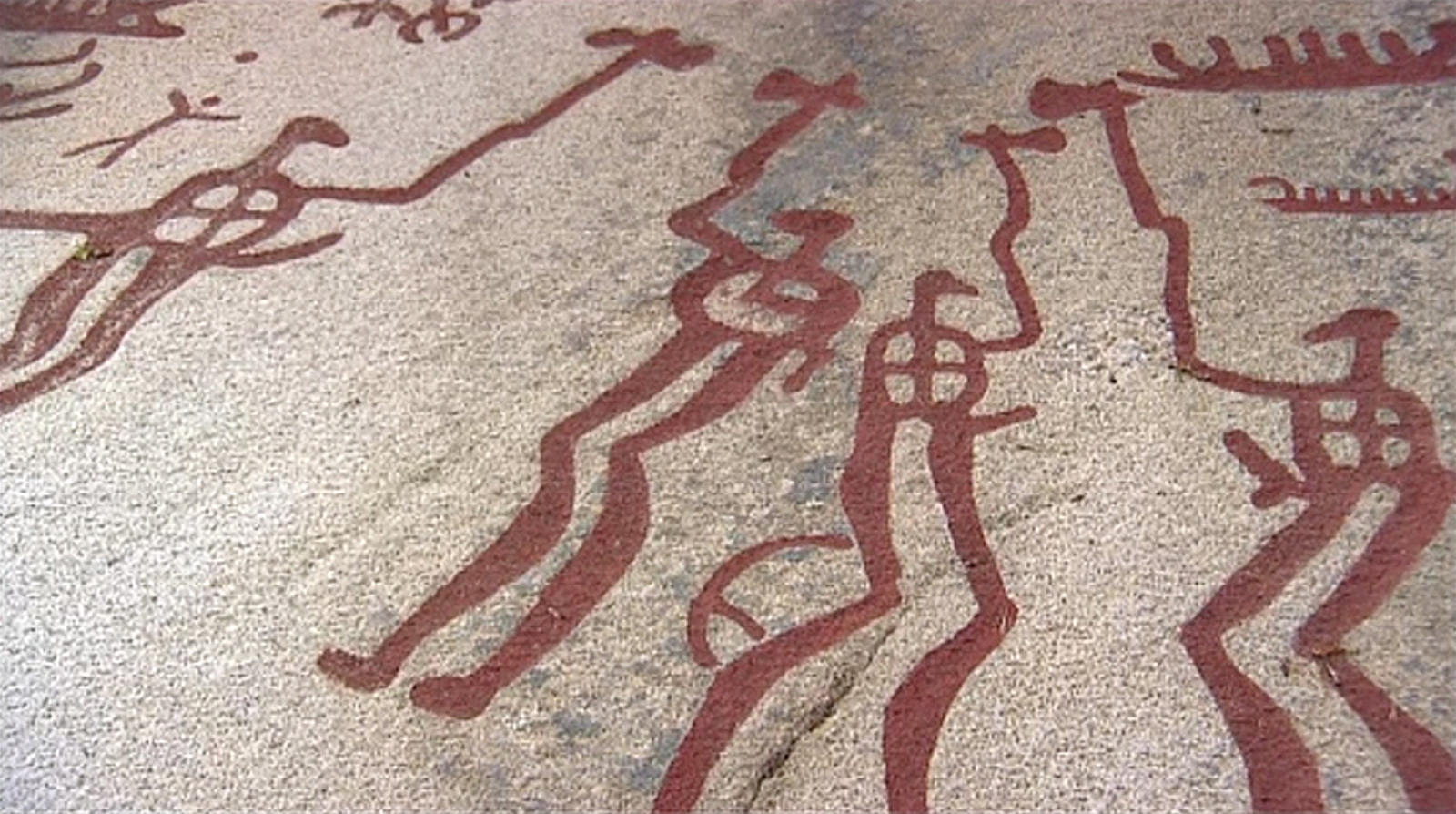

The rock carvings are endangered by erosion due to acid rain and some are thus covered either permanently or during certain times of the year. Some have been painted red to make them more visible for tourists; a practice which has drawn criticism for removing the authenticity and original state of the drawings.
It is visited by approximately 100,000 visitors per year, though visitors are not permitted to walk on or touch the drawings.
The coordinates are 58°42’4”N 11°20’28”E

